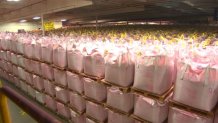Where there's smoke, there's fire, and often a bright pink cloud descending on burning hillsides in Southern California.
That cloud dropped from firefighting aircraft is a fire retardant called PHOS-CHEK, a sign of relief for firefighters trying to increase containment lines on the ground. The widely used chemical that helps slow the spread of flames is produced at a factory in Rancho Cucamonga east of Los Angeles.
PHOS-CHEK essentially turns dry brush and other fire fuels into something non-flammable.
But why is it pink?
Get Southern California news, weather forecasts and entertainment stories to your inbox. Sign up for NBC LA newsletters.
"We tested every color in the rainbow, and the pink was by far the most visible. And, it's pretty," said Melissa Kim, vice president of research and development at Perimeter Solutions.
The bright color allows firefighters to see where the PHOS-CHECK has been dropped and where it hasn't. Ground crew can then create fire lines around it, potentially saving lives and property.
"If you can't see it, then it's essentially not effective," Kim said. "The purpose is they're flying in high smoke, low visibility with winds. The pilots have to get it right the first time. This job doesn't offer many second chances."
The product was created about 60 years ago. The recipe is a guard secret, but the main ingredient is phostphate, basically fertilizer that can be stored for many years. The phosphates react with vegetation to prevent it from catching fire.
The recipe has gone through some changes, including a formula that won't leave a permanent stain on hillsides, homes and cars.
The Rancho Cucamonga company produces PHOS-CHEK as a powder that's then delivered anywhere around the world. The urgent nature of wildfires means shipments of the 2,000-pound bags must be ready to go.

"We are an emergency response business, so when we get an order we ship within hours," said Oscar Sanchez, who has worked at Perimeter Solutions for 25 years. "So we are always on alert, always on call 24-7."
After the sacks are delivered, to air attack bases, the powder is mixed with water and loaded into firefighting aircraft.
"So all the aircraft you see dropping retardant, this is what they're dropping," Sanchez said. "It does give us a sense of pride because it was a lot of hard work to get there."



